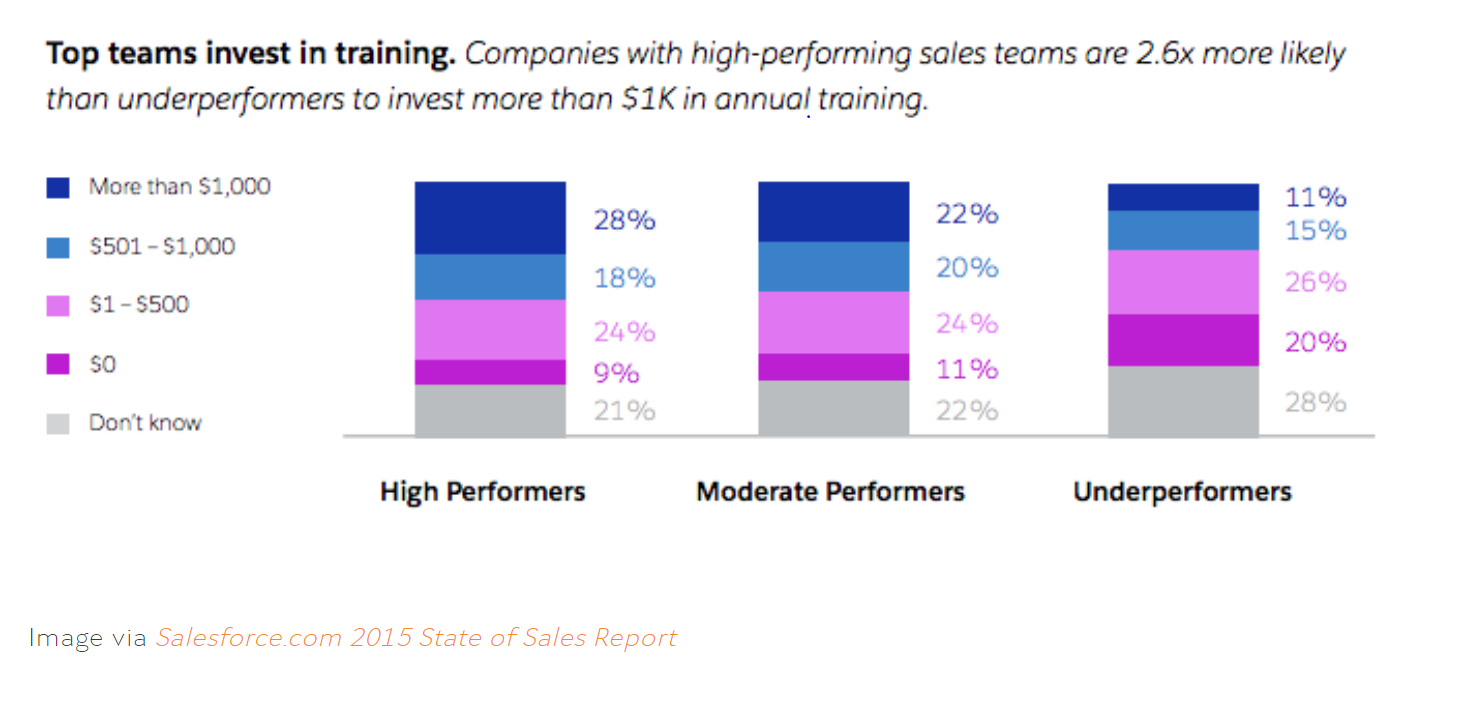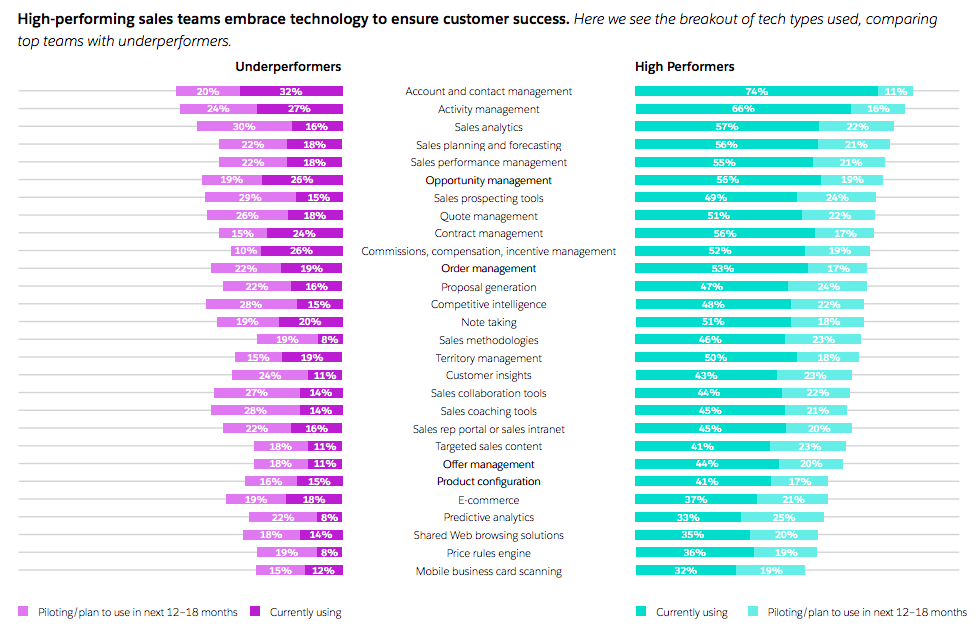1 min read
Most Staffing Firms are Not Built to Scale, But to Survive
Most staffing firms don’t struggle to scale because their teams aren’t working hard. They struggle because they don’t have a real go-to-market...

Sales quotas continue to rise year after year despite the fact that Salesforce.com's State of Sales report found that 57% of all salespeople fail to meet sales quota. To close this gap organizations are investing in sales training, in the form of both online sales training and instructor-led sales training.
We've found that very few organizations have a systematic strategy for learning and development including a sales training budget to support their people in helping them meet and exceed quota. My intention with this blog is to share with you the key considerations to account for when establishing your sales training budget. Additionally, I have dug up some data points that demonstrate how high performing sales organizations invest their sales training budget including how much they invest per employee vs. under performing sales organizations.
How Much Do Companies Invest in Training Their Sales People?How Much Should You Plan on Investing in Sales Training Per Rep?

Another study conducted by Salesforce.com showed there is a direct correlation between higher levels of sales training investment and sales team performance. Under performing sales organizations are nearly ⅔ more likely to spend less than $1k on sales training per sales rep annually. What is interesting is the dollar amount companies have invested over the years hasn't really changed all that much.

According to a study conducted by CSO Insights, in 2011, 40% of companies spent over $500 per sales rep annually on sales training. Those number are nearly identical in 2016. So if the investment in sales training and budgets for sales training has remained the same over the past several years, what can under performing companies learn from those high performing companies who are keeping their budgets flat but are still seeing improved results and outperforming the market?
How High Performing Sales Organizations Allocate Their Budget
As it turns out, the leaders in the high performing sales organizations spend their budgets far differently than those leading under performing sales teams. Overall, high performing sales teams tend to be early adopters and invest more heavily in technology solutions than their under performing counterparts. The chart below, also taken from the Salesforce.com report shows how leaders of high performing organizations invest in their sales teams vs. those leading under performing sales teams.

For example, Sixty-six percent of high performing sales teams are either using or planning to use or pilot tech-based sales coaching tools in the next 12-18 months. Only 28% of under performing sales organizations are actively using sales coaching tools like sales rep assessments and AI technology.
Another big discrepancy is with sales management in which 55% of high performing sales organizations are leveraging sales performance management technologies- and another 21% are either piloting sales performance management programs or are planning to roll it out within the next 12-18 months. Under performing sales teams are nearly 50% less likely to see this as a priority in their budgets.
Now that we have a sense for what other organizations are spending on sales training, learning and development and how they are allocating their budget, let's turn our attention to the key elements you should consider when developing your sales training budget.
Get Clear on Your Sales Strategy
As you think about building your sales training budget you should begin by focusing on the big picture. What is your organization and your sales team trying to accomplish in the upcoming year? How has that changed in the last year, if at all? For example, are you going after a new or different target market? Are you asking your sales team to sell to new or different buyer personas? Perhaps you want your sales team to sell more projects or statement of work (SOW) business. What new skills or knolwedge will you need to equip your sales team with in order to achieve your goals? Keep in mind that at this level of analysis you will likely have multiple goals and strategies so you will have to prioritize what is most important and make some concessions or tradeoffs. If you can't do everything than you should think about what is most important, highest impact.
What is the Growth Stage of Your Company?
The amount of time and the size of your sales training investment also depends on what stage of growth your company is in. If you have one or two key performers bringing in 80% of the revenue or if you're the owner bringing in 80% or more of the revenue and you're really looking to scale the business, then you will need to spend the majority of your time (and capital) working with your salespeople ensuring they articulate the value proposition exactly how you want them to. As the business grows and you hire managers you can then focus on teaching your managers the desired sales behaviors, but that doesn't mean as the owner or leader that you should no longer be involved in sales training.
Align Your Sales Strategy with the Required Individual Skill and Behavior Competencies
Once you have clarity around your sales strategy it is time to take your thinking down to the individual level. What training do your front line sales managers and recruiting managers need? What do you need your managers to do differently in order to execute on your sales strategy and achieve your goals? What skill development is required on behalf of your managers and your sales reps? How significant of a change (in behavior) are you asking of them? This is an important question because the degree of change will dictate the level of effort required to train and sustain newly desired behaviors.
Finally, before you determine what training you want or need, you first need to determine the capabilities of your sales managers and sales reps. You should assess or benchmark each of your sales reps strengths and weaknesses against the desired skills and behaviors you seek.
Factors to Consider for Your Sales Training Budget
There are a number of factors to consider when creating your sales training budget. Below are a few of the most common to consider:
How to Justify the ROI
Your sales training dollars need to drive revenue growth so you will need to justify your budget with some concrete ROI numbers and proven analytics. To justify your investment in sales training it's important to have a few key goals that you can easily track and measure. Here are a few to consider.
Your sales training investment should align with your business goals including the stage of your organization. Just make sure that your learning and development strategy is clearly connected to and supports your company strategy. Aligning your training strategy with the goals of the company is a great way to gain buy-in from executive leadership as most leadership teams will respond well to any initiative that supports their overarching goals and strategy.
To learn more about tracking and measuring sales training ROI, download our eBook, The Definitive Guide to Tracking and Measuring Sales Training ROI.

1 min read
Most staffing firms don’t struggle to scale because their teams aren’t working hard. They struggle because they don’t have a real go-to-market...

In my previous post, How to Prevent Unexpected Contract Terminations, I shared how systemizing consultant and client check-ins at key milestones...

About a year ago, I was serving as the fractional revenue leader, managing sales and recruiting for a client.